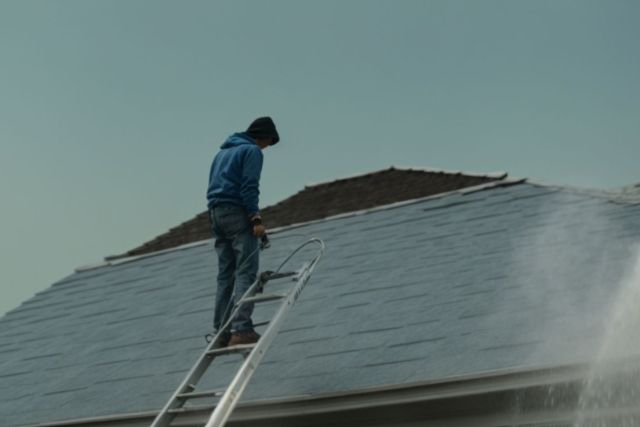Pressure washing is a popular method for cleaning various surfaces, including roofs. In this article, we will explore why pressure washing a roof is beneficial, the equipment needed for the job, how to prepare for the process, and step-by-step instructions on how to pressure wash a roof effectively.
We will provide some useful tips to ensure a successful roof-cleaning project. Whether you are a seasoned pro or a beginner, this guide will help you achieve a clean and well-maintained roof.
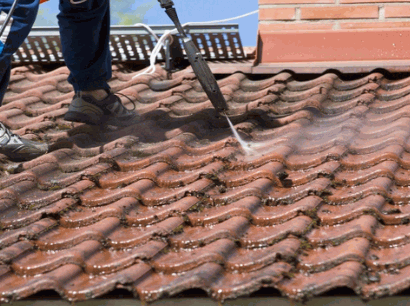
What Is Pressure Washing?
Pressure washing is a method of cleaning surfaces using high-pressure water spray to remove dirt, grime, mold, and other contaminants.
This technique is highly effective for roof cleaning, as it can efficiently get rid of stubborn stains, algae, moss, and debris that accumulate over time. The use of pressure washers with adjustable nozzles allows for customized pressure levels suitable for different types of roofing materials. When properly executed, pressure washing not only enhances the appearance of the roof but also helps in preventing issues like water damage and deterioration. By using eco-friendly detergents and applying proper techniques, pressure washing can be a safe and efficient method for roof maintenance.
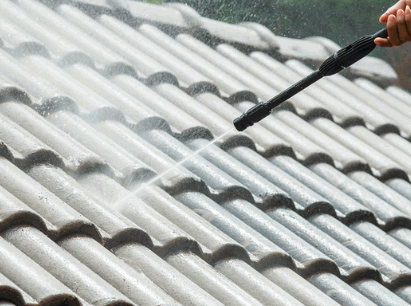
Why Pressure Wash A Roof?
Pressure washing a roof is essential for removing dirt, algae, mold, and stains that can damage the roof material and compromise its structural integrity.
Utilizing the appropriate water pressure during the cleaning process is crucial to ensure that the roof is effectively cleaned without causing any harm to the underlying materials. Algae and mold removal not only enhances the aesthetic appeal of the roof but also prolongs its lifespan by preventing decay and deterioration.
By eradicating these contaminants, pressure washing helps maintain a healthy roof environment and prevents potential health hazards associated with mold growth. Regular pressure washing helps in identifying any underlying issues early on, allowing for timely repairs and maintenance to avoid costly damages in the long run.
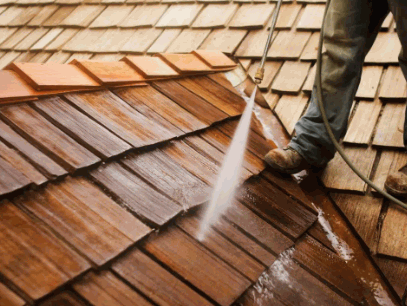
Removes Dirt And Debris
Pressure washing effectively removes dirt and debris from the roof surface, improving its cleanliness and appearance while preventing blocked gutters.
The process of pressure washing involves using a high-pressure water spray to dislodge dirt, grime, and other build-up from the roof. This not only enhances the overall aesthetic of the property but also plays a crucial role in maintaining the structural integrity of the roof. By eliminating debris, it helps prevent water pooling, which can lead to leaks and damage.
Regular cleaning through pressure washing helps to ensure that the surface run-off is not impeded, reducing the risk of water damage and erosion. Proper maintenance of gutters through this method prevents blockages that can result in water overflow and potential structural issues.
Uncover more: How To Clean Window Screens Without Removing Them
Prevents Damage
Regular pressure washing helps prevent damage to the roof material by removing contaminants that can deteriorate its surface and compromise its integrity.
Utilizing a professional pressure washing service ensures that the process is carried out efficiently, without causing any harm to the roof's surface. By using the right techniques and equipment, the cleaning is done thoroughly, reaching deep-seated dirt and grime that could otherwise lead to decay. This proactive approach not only safeguards the appearance of the roof but also extends its lifespan, ultimately saving homeowners from expensive repairs or premature replacements. Maintaining the cleanliness of the roof through periodic pressure washing can be considered a long-term investment in the protection and preservation of the property.
Improves Curb Appeal
Pressure washing not only maintains the roof's functionality but also enhances its visual appeal, contributing to the overall aesthetics and increasing the property's value.
By removing dirt, mold, mildew, and other debris that accumulate on the roof over time, pressure washing helps restore the roof's original color and shine. The process also plays a vital role in preventing potential damage caused by the growth of algae and moss, which can deteriorate the roof surface. Regular upkeep through pressure washing not only ensures a pristine look but also extends the lifespan of the roof, ultimately protecting the property investment.
What Equipment Do You Need for Pressure Washing A Roof?
To pressure wash a roof effectively, you will need specific equipment such as a pressure washer, the right nozzles for varying pressure levels, and suitable detergents for roof cleaning.
- When selecting the nozzles for your pressure washer, it's important to consider the water pressure needs of your roof. For low-pressure cleaning, a wide-angle nozzle is ideal to protect delicate roof materials. Conversely, a narrow, high-pressure nozzle can tackle tough stains on more durable surfaces.
- Proper detergent application involves pre-soaking the roof with a roof-cleaning solution before starting the pressure washing process. Maintaining your pressure washing equipment, including regular filter checks and nozzle cleanings, is crucial for optimal performance and longevity.
Pressure Washer
The pressure washer is the primary tool for roof cleaning, offering options for high-pressure washing, low-pressure washing, or soft washing based on the roof material and cleaning requirements.
- High-pressure washing is effective for removing tough stains and mold, but it may not be suitable for delicate roof materials like tiles.
- Low-pressure washing, on the other hand, uses less force and is ideal for more fragile roofs.
- Soft washing involves a combination of low-pressure and specialized cleaning solutions to gently cleanse the roof surface without causing damage.
Choosing the right sprayer technique is crucial to prevent any potential harm and ensure thorough cleaning.
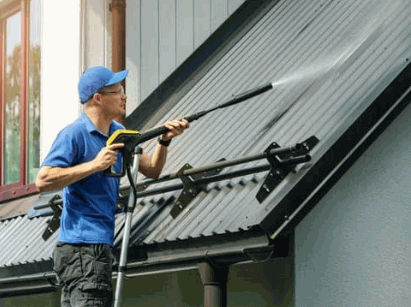
Extension Wand
An extension wand is crucial for reaching high or steep roofs safely, ensuring proper surface preparation, and minimizing risks associated with ladder use during roof pressure washing.
Using an extension wand not only allows the pressure washing equipment to reach elevated areas without the need to climb on precarious ladders but also enables thorough cleaning of the roof surface, ensuring effective removal of dirt, moss, and debris.
Proper surface preparation is essential for achieving optimal results, as it helps in removing loose materials and creating a clean foundation for the cleaning process.
When dealing with challenging roof cleaning tasks, it is highly recommended to hire trained professionals who have expertise in handling various roof materials and surfaces safely and efficiently, minimizing the risk of damage and ensuring a job well done.
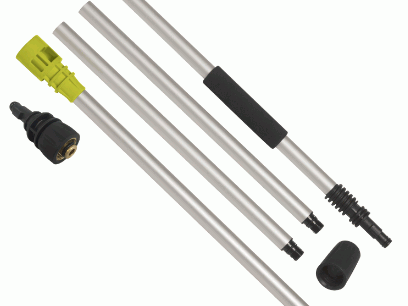
Safety Gear
Proper safety gear, including goggles, gloves, and non-slip footwear, is essential when pressure washing a roof to ensure personal safety, prevent accidents, and protect the environment.
Gutter protection is also crucial during roof pressure washing to prevent debris buildup and maintain the flow of rainwater, reducing the risk of water damage and prolonging the life of the roof.
Opting for eco-friendly cleaning solutions not only ensures a sustainable process but also minimizes the environmental impact of the cleaning operation.
By incorporating these safety precautions and environmentally conscious practices, homeowners can enjoy a clean roof while promoting safety and sustainability.
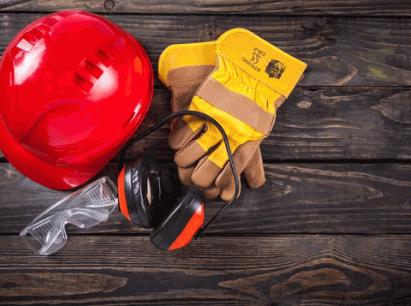
How To Prepare For Pressure Washing A Roof
Before starting the pressure washing process, it is crucial to conduct a thorough roof inspection, remove debris, protect surrounding plants, consider weather conditions, and select appropriate cleaning solutions.
- Beginning with a comprehensive roof inspection allows you to identify any areas needing extra attention or repairs before applying pressure washing.
- Clearing debris from the roof surface and gutters not only prevents blockages and potential water damage but also ensures a more effective cleaning process.
- Safeguarding nearby plants from the cleaning solutions is essential to prevent any harm.
- Taking into consideration weather factors, such as temperature and humidity, can impact the cleaning efficiency and drying time.
- It's also essential to choose cleaning solutions tailored to the specific material of your roof for optimal results.
Check For Damage
Before pressure washing, inspect the roof for any signs of damage, such as cracks or leaks, and take precautionary steps to prevent further issues while following proper roof safety guidelines.
It is crucial to check for loose or missing tiles, as they could indicate underlying roof problems. As you conduct the inspection, be mindful of any sagging areas or watermarks, as these may be indicative of water penetration. Algae growth is also a common issue, which can be addressed by implementing preventive measures such as installing zinc or copper strips along the roof ridges. Following a comprehensive roof care guide will ensure that the roof remains in optimal condition, extending its lifespan and preserving its structural integrity.
Remove Debris
Efficient debris removal from the roof surface before pressure washing not only improves cleaning efficiency but also ensures quality results and reduces long-term maintenance costs.
This initial step of clearing debris plays a crucial role in preparing the surface for pressure washing. By removing leaves, branches, and other forms of buildup, you create a clean canvas for the water pressure to work its magic effectively. Without proper debris removal, the pressure washing process may be hindered, leading to inconsistent results and potential damage. By investing time in thorough cleanup beforehand, you set the foundation for a more pristine finish and extend the longevity of your roof, ultimately saving you money on future maintenance and repairs.
Protect Surrounding Areas
To minimize the environmental impact of pressure washing, protecting surrounding areas from runoff, practicing routine maintenance, and conserving water are essential considerations during the cleaning process.
- When water from roof pressure washing runoff containing chemicals and debris flows into storm drains and water bodies, it can harm aquatic life and pollute the environment. Implementing strategies such as using biodegradable cleaning products, directing runoff to permeable surfaces for filtration, and capturing and recycling water can significantly reduce these negative effects.
- Regular maintenance of roofs can prevent excessive dirt and debris buildup, minimizing the need for intensive cleaning processes that can have a greater environmental footprint. Conserving water by adjusting pressure washing equipment settings and utilizing water-efficient techniques further contributes to sustainable cleaning practices that benefit the ecosystem in the long run.
How To Pressure Wash A Roof
Achieving optimal results in roof pressure washing requires following expert advice, using professional tips, and adhering to a consistent cleaning schedule to maintain the roof's cleanliness and appearance.
Before starting the pressure washing process, it is essential to ensure that all necessary safety precautions are in place. This includes wearing appropriate safety gear such as goggles and gloves, and making sure the surrounding area is clear of any obstacles.
Begin by carefully inspecting the roof for any signs of damage or loose tiles to preemptively address any issues. Use a gentle detergent solution or specialized roof cleaner to pre-treat any stubborn stains before applying the pressure washer. Remember to work in small sections, moving systematically to cover the entire roof surface evenly for a thorough clean.
Set Up Pressure Washer
Properly setting up the pressure washer according to best practices ensures surface preparation, avoids damage to the roof material, and may include the use of chemical-free options to extend the roof's lifespan.
Before commencing roof pressure washing, it is crucial to start by gathering all necessary equipment such as extension wands, a proper nozzle for the job, and safety gear including goggles and gloves.
Next, inspect the roof for any loose shingles or debris that must be cleared before beginning the pressure washing process. Consider trimming any nearby tree branches that could obstruct the cleaning process or pose a risk.
By following these setup steps meticulously, you set the stage for a successful and efficient roof cleaning operation.
Start At The Top
When pressure washing a roof, start at the top and work your way down to ensure thorough cleaning, adhere to recommended cleaning frequency guidelines, and follow do's and don'ts to protect your investment in roof maintenance.
This top-down approach is crucial to prevent streaking and ensure that debris and grime are effectively removed. Different roof materials have varying cleaning requirements; for instance, asphalt shingles may need cleaning every 1-3 years, while metal roofs could benefit from annual cleanings. Remember to use gentle pressure settings to avoid damaging the roof surface.
Regular roof maintenance not only enhances curb appeal but also extends the roof's lifespan, saving you from costly repairs down the line.
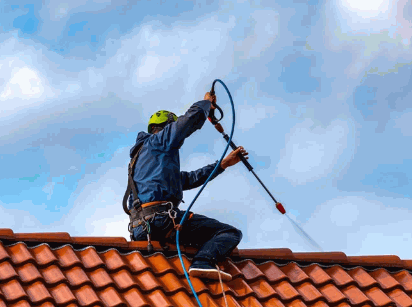
Use A Gentle Spray
Using a gentle spray during roof pressure washing is recommended to avoid surface damage, maintain visual appeal, adhere to care and maintenance guidelines, and select appropriate cleaning solutions based on seasonal cleaning requirements.
This approach not only safeguards the roof from potential harm caused by high-pressure methods but also extends the longevity of the roof. By opting for a gentle spray, homeowners can effectively remove dirt, debris, and organic growth without risking structural integrity.
Following care and maintenance protocols for roof cleaning ensures that the roof remains in top condition, enhancing its overall aesthetic appeal. Tailoring the choice of cleaning solutions to different seasonal needs allows for a customized cleaning regime that targets specific issues prevalent during each time of the year.
Rinse Thoroughly
Thoroughly rinsing the roof after pressure washing is crucial for home improvement, adopting eco-conscious solutions, preserving roof aesthetics, and mastering effective sprayer techniques for optimal cleaning results.
By rinsing thoroughly post-pressure washing, homeowners can effectively remove any remaining dirt, grime, or cleaning solution residues that may be left behind. This step not only helps in achieving a pristine appearance but also ensures that the roof is free from any potentially damaging substances.
Embracing eco-friendly cleaning agents promotes sustainable practices, safeguarding both the environment and the well-being of those residing in the home. Preserving the aesthetics of the roof plays a key role in enhancing the overall curb appeal of the property, making a lasting impression on visitors and potential buyers alike.
Mastering sprayer techniques involves understanding the right angle, distance, and pressure to apply during the cleaning process, leading to optimal outcomes and a refreshed look for the entire home.
Clean Gutters And Downspouts
Don't forget to clean gutters and downpipes while pressure washing a roof, especially for commercial roofs, to avoid common mistakes, ensure gutter protection, and comply with industry standards for roof cleaning.
Neglecting proper gutter and downpipe cleaning during roof pressure washing can lead to blockages, which can prevent proper drainage and cause water damage. For commercial roofs, where larger surface areas are involved, ensuring clear gutters is crucial for preventing structural issues and maintaining the integrity of the building. It is essential to follow industry guidelines and best practices for roof cleaning services, including incorporating gutter protection measures to prolong the effectiveness of the cleaning process and minimize the need for frequent maintenance.
What Are Some Tips For Pressure Washing A Roof?
To enhance the effectiveness of roof pressure washing, consider tips such as ladder safety, tackling steep roofs cautiously, maintaining equipment, and following roof safety guidelines for a successful cleaning experience.
- When it comes to ladder safety, always ensure that the ladder is stable and securely positioned before climbing. Use a ladder with rubber feet or another non-slip material to prevent accidents.
- When cleaning steep roofs, proceed with extra caution to avoid slips or falls. Regular maintenance of your pressure washing equipment is crucial for optimal performance and longevity. Be sure to check for any leaks, clogs, or worn-out parts before starting a cleaning session.
- Adhering to specific safety guidelines for your particular type of roof material is key to a smooth and efficient cleaning process.
Use A Low-Pressure Setting
When pressure washing a roof, using a low-pressure setting helps prevent dirt buildup, implement preventive measures, consider hiring trained professionals for complex jobs, and conduct a thorough roof inspection before cleaning.
This gentle approach to roof pressure washing not only safeguards the integrity of the roof material but also extends the longevity of its structure. By ensuring a clean surface without damage, the risk of future issues like leaks or mold growth is significantly reduced.
Investing in regular professional assistance for more intricate cleaning tasks can save both time and money in the long run, as experts possess the expertise and equipment necessary for a thorough and safe cleaning process. A comprehensive roof inspection before any cleaning activity can identify potential problems early, allowing for timely interventions and maintenance to prevent costly repairs down the line.
Work In Small Sections
Dividing the roof into small sections during pressure washing aids in targeting stubborn stains, conserving water resources, facilitating roof restoration efforts, and achieving quality cleaning results.
By breaking down the roof into manageable portions, the pressure washing process becomes more focused and efficient. This approach allows the cleaner to pay close attention to each section, ensuring that no spot is overlooked. Working in small sections promotes water conservation by only using the necessary amount for each area, reducing wastage. It also supports roof restoration initiatives as it enables thorough cleaning, and preparing the surface for any necessary repairs or treatments. Ultimately, this method guarantees that the cleaning process is carried out meticulously, leading to a pristine and well-maintained roof.
Avoid Using Hot Water
Avoid using hot water for roof pressure washing to promote sustainability, safeguard your investment in roof maintenance, prevent surface damage, and maintain high cleaning efficiency levels during the process.
Instead of relying on hot water, opting for cooler temperatures can significantly benefit the cleaning process in various ways. Cooler water is more environmentally friendly as it does not require heating, reducing energy consumption and carbon emissions. This aligns with the goal of sustainability and eco-conscious practices.
Using lower water temperatures helps protect the roof's integrity and lifespan by minimizing the risks of thermal shock and potential damage caused by excessive heat. By adjusting the temperature settings, cleaning operations can be carried out efficiently while ensuring optimal results without compromising the effectiveness of the wash.
Take Breaks And Stay Hydrated
Remember to take breaks and stay hydrated whilst pressure washing a roof, following proper methods for effective cleaning, enhancing cleaning efficiency, considering eco-friendly options, and adhering to a comprehensive roof care guide.
Maintaining hydration levels is crucial as prolonged exposure to the sun and physical exertion can lead to dehydration, impacting one's performance.
By utilizing proper cleaning techniques such as low-pressure washing and biodegradable cleaning solutions, you ensure thorough cleaning without damaging the roof.
Exploring eco-friendly alternatives like vinegar-based cleaners not only reduces environmental impact but also promotes a healthier living environment.
Following a detailed roof care guide, including regular inspections and repairs, is essential to prolong the lifespan of your roof and maintain its pristine condition.

